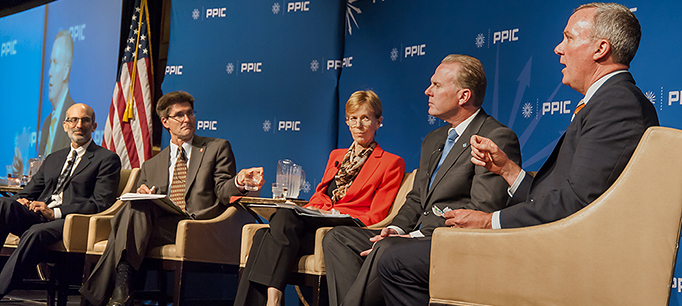Mark Baldassare, PPIC’s president and CEO, opened the PPIC conversation on climate change this week with these remarks. We invite you to watch the video of the event.

California has found its way to broad, bipartisan agreements on environmental issues for decades. The state has been a leader in efforts to improve air quality, conserve open space, and protect the coastline. The public has typically embraced these “green” policies. In a PPIC poll in 2014, majorities of Californians said that “stricter environmental laws and regulations are worth the cost,” while fewer said they “cost too many jobs and hurt the economy.” Despite increasing evidence that climate change poses a major threat here and abroad, the federal government and international community have been slow to act. California, on the other hand, has been responding since the early 2000s with some of the most far- reaching policies in the world.
Most notably, Republican Governor Arnold Schwarzenegger joined Democratic legislators and signed AB32 – the Global Warming Solutions Act—in 2006. It committed California to reverse the trend of rising greenhouse gas emissions and to lower those emissions to 1990 levels by the year 2020. It was hailed as a watershed moment in California history that would also have far-reaching consequences nationally and internationally.
In the years that followed, the governor and legislature worked to comply with the law by adopting a number of major policy changes. These include efforts to expand renewable energy, change community development, and create a market price for carbon through a cap and trade program. In 2010, a campaign led by Democrat Tom Steyer and Republican George Shultz persuaded voters to soundly reject Proposition 23, an initiative to suspend AB32. Voters then passed Proposition 39 by a wide margin. This 2012 initiative closed corporate tax loop holes to pay for clean energy projects.
The state’s response to climate change has had consistent support from a broad coalition that cuts across racial/ethnic, economic, and regional groups—while the amount of support has varied along partisan lines. In the PPIC annual environment survey last July, 68 percent of adults said they favored the emission goals identified in AB32. Strong majorities have expressed support for the law since we first asked about it in 2006. Sixty-five percent of Californians are also in favor of the state government making its own policies to address global warming—separate from the federal government. Majorities have expressed this preference since we first asked about it in 2005. And sixty-one percent say that the state government should act right away to reduce global warming rather than wait for the economy and job situation to improve.
One reason the state’s response to climate change has had such strong support is the high level of concern about the issue among Californians. In a PPIC poll last December, 76 percent of adults said that global warming is a very serious or somewhat serious threat to the economy and quality of life in California. More than seven in 10 have expressed this view since we started asking this question in 2005.
Another explanation for Californians’ support is the perceived economic benefit of the state’s policies. In the PPIC poll last December, 43 percent of adults said that California’s efforts to reduce global warming will result in more jobs for people around the state. In contrast, 29 percent said the state’s effort will not affect job numbers, and only 21 percent said it will result in fewer jobs. Californians have always been much more likely to say that taking action on global warming will result in more jobs— rather than fewer—since we began asking this question in 2010.
Today, California climate change policy has reached another pivotal moment. Last year, the state Air Resources Board declared that California is now on track to achieve its greenhouse gas emission goals by 2020, just five years from now. Earlier this year, Governor Brown and state legislators proposed that California recalibrate its climate change policies with a new set of goals reaching farther into the future. As before, the new goals are ambitious and contentious.
In January, Governor Brown proposed three new goals to be accomplished in the next 15 years: increase the amount of electricity produced from renewable sources from one-third to 50 percent; reduce today’s petroleum use in cars and trucks by up to 50 percent, and; double the energy efficiency of buildings and make heating fuels cleaner. SB 350 by Senators Kevin de Leon and Mark Leno reflects the governor’s new goals for 2030. And SB 32 by Senator Fran Pavley would set California’s greenhouse gas emissions in the year 2050 at 80 percent below the level reported in 1990.
There is much to consider in setting these goals and we know that change of this magnitude is not easy. Governor Brown said in his inaugural address: “Taking significant amounts of carbon out of our economy without harming its vibrancy is exactly the sort of challenge at which California excels. This is exciting, it is bold, and it is absolutely necessary if we are to have any chance of stopping potentially catastrophic changes to our climate system.”
California can benefit from the innovation, technologies, and new jobs generated by the state’s leadership on climate change policy. Achieving the goals, however, will also have costs and require lifestyle changes around transportation, employment and housing decisions.
The climate change policies in place today and the proposed goals will affect every Californian. To talk about some of the experiences so far and the issues raised by a new set of climate change goals, we have put together a bipartisan panel that reflects several key perspectives. The panel includes state and local government representatives, as well as business interests from different sectors of the economy.
The state’s climate change policies are among the most difficult and important issues to surface this year. We hope that a public dialogue about the challenges that we face, the goals under consideration, and the trade-offs involved in upcoming policy choices will help California to achieve its brightest future.


